Elevate your dessert game with this tangy thyme-lemon shortcake, inspired by herbal tea flavors. You'll infuse a classic shortcake base with fresh thyme and zesty lemon, creating a sophisticated twist on a beloved treat. The aromatic herbs and bright citrus notes balance perfectly with a creamy filling, offering a revitalizing and indulgent experience. You can easily adapt this recipe for different seasons, incorporating lavender in spring or warming spices in autumn. Not only delicious, this dessert also boasts health benefits from thyme's antioxidant properties. Discover how to perfectly pair your shortcake with complementary teas for an unforgettable culinary adventure.
Herbal Tea Dessert Inspiration

Blending the soothing flavors of herbal teas with desserts opens up a world of unique culinary possibilities. You'll find that incorporating herbal tea elements into your sweet treats can elevate them from ordinary to extraordinary. Consider the aromatic notes of chamomile, lavender, or mint as potential flavor enhancers for your next dessert creation.
Start by exploring popular herbal tea blends and identifying their key ingredients. Lemon balm, rosehip, and hibiscus can add a tangy twist to fruit-based desserts, while earthy tones from rooibos or mate can complement chocolate confections.
Don't forget about the visual appeal – dried flower petals from herbal teas can make stunning garnishes.
Experiment with infusing cream or milk with herbal tea bags before using them in custards, ice creams, or mousses. You can also grind dried herbs to a fine powder and incorporate them directly into batters or doughs.
For a more intense flavor, try steeping herbs in hot syrup to create a flavored simple syrup for drizzling over cakes or mixing into frostings.
Thyme and Lemon Flavor Profile
The harmonious pairing of thyme and lemon creates a flavor profile that's both invigorating and sophisticated. When you combine these two ingredients, you'll experience a burst of bright, citrusy notes from the lemon, complemented by the earthy, slightly minty undertones of thyme. This combination offers a perfect balance between tart and herbal flavors, making it ideal for both savory and sweet applications.
In desserts, the thyme and lemon duo adds a rejuvenating twist to traditional recipes. The lemon's acidity cuts through rich, sweet flavors, while thyme provides a subtle, aromatic depth. You'll find that this pairing works exceptionally well in shortcakes, tarts, and custards.
To fully appreciate the thyme and lemon flavor profile, you'll want to use fresh ingredients whenever possible. Zest your lemons to capture their essential oils, and gently bruise fresh thyme leaves to release their aromatic compounds.
When incorporating these flavors into your desserts, remember that a little goes a long way. Start with small amounts and adjust to taste, ensuring that neither the thyme nor the lemon overpowers the other.
Shortcake Base Recipe
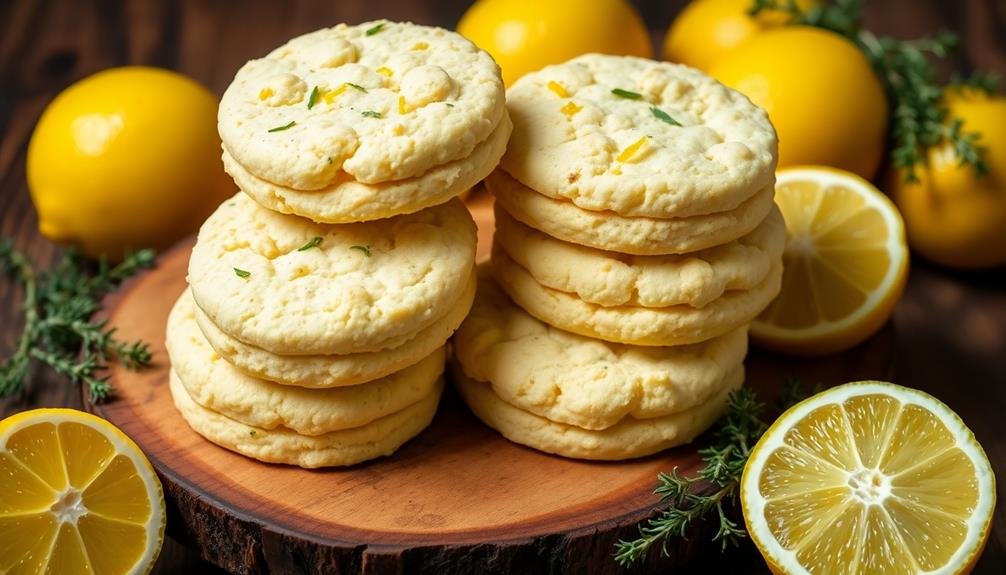
You'll need flour, sugar, baking powder, salt, butter, and milk for the shortcake base.
Mix the dry ingredients, then cut in the cold butter until the mixture resembles coarse crumbs.
Add milk gradually, stirring until a soft dough forms, then bake in a preheated oven until golden brown.
Ingredients and Measurements
For the shortcake base, gather these essential ingredients: 2 cups all-purpose flour, 1/4 cup granulated sugar, 1 tablespoon baking powder, 1/2 teaspoon salt, 6 tablespoons cold unsalted butter, 2/3 cup cold milk, and 1 teaspoon vanilla extract.
You'll need to measure these ingredients precisely for the best results. Use a kitchen scale for accuracy, especially when measuring the flour. If you don't have a scale, spoon the flour into your measuring cup and level it off with a straight edge. Don't pack it down.
For the butter, cut it into small cubes and keep it cold until you're ready to use it. This will help create a flaky texture in your shortcake.
When measuring the milk, use a liquid measuring cup and check the measurement at eye level for accuracy.
Don't forget to add 1 tablespoon of fresh thyme leaves and 1 tablespoon of lemon zest to infuse your shortcake with the herbal tea-inspired flavors. These ingredients will give your dessert a unique and invigorating twist that sets it apart from traditional shortcake recipes.
Mixing and Baking
Mixing the shortcake base is a straightforward process that'll yield delicious results. Begin by creaming the butter and sugar until light and fluffy. Add the eggs one at a time, beating well after each addition.
In a separate bowl, whisk together the flour, baking powder, salt, and dried thyme. Gradually add this dry mixture to the wet ingredients, alternating with the lemon juice and milk. Mix until just combined, being careful not to overmix.
Preheat your oven to 375°F (190°C) and line a baking sheet with parchment paper. Drop the batter by spoonfuls onto the prepared sheet, leaving space between each shortcake. Bake for 15-18 minutes or until golden brown and a toothpick inserted in the center comes out clean.
To guarantee perfect shortcakes every time, follow these tips:
- Use cold butter for a flakier texture
- Don't overmix the batter to avoid tough shortcakes
- Rotate the baking sheet halfway through for even browning
- Let the shortcakes cool completely before assembling
- Store leftovers in an airtight container for up to 3 days
Once cooled, you're ready to assemble your tangy thyme-lemon shortcakes with the prepared toppings.
Infusing Thyme Into Shortcake Dough
To infuse thyme into your shortcake dough, you'll need to master a few key preparation techniques.
You can finely chop fresh thyme leaves or use dried thyme, but be careful not to overpower the dough with too much herb flavor.
Striking the right balance is essential, so start with a small amount and adjust to taste, ensuring the thyme complements rather than dominates the shortcake's sweet profile.
Thyme Preparation Techniques
Thyme's delicate flavor can elevate your shortcake dough from ordinary to extraordinary. To prepare thyme for infusion, start by selecting fresh sprigs with vibrant green leaves. Gently wash and pat them dry to remove any dirt or debris. Strip the leaves from the stems by holding the top of the sprig and running your fingers down the stem against the direction of growth.
For the best flavor infusion, consider these techniques:
- Chop the leaves finely to release their aromatic oils
- Crush the leaves with a mortar and pestle for a more intense flavor
- Steep whole leaves in warm milk before adding to the dough
- Blend dried thyme into the flour for even distribution
- Create a thyme-infused sugar by rubbing leaves into granulated sugar
When incorporating thyme into your shortcake dough, remember that a little goes a long way. Start with a small amount and adjust to taste.
You can also experiment with different varieties of thyme, such as lemon thyme or orange thyme, to create unique flavor profiles. By mastering these preparation techniques, you'll reveal the full potential of thyme in your dessert creations.
Balancing Flavors Effectively
The art of balancing flavors in shortcake dough requires a delicate touch when infusing thyme. You'll want to start by finely chopping fresh thyme leaves, ensuring they're evenly distributed throughout the dough. Aim for about 1 tablespoon of chopped thyme per 2 cups of flour. This ratio provides a subtle herbal note without overpowering the shortcake's classic taste.
When incorporating thyme, mix it with the dry ingredients before adding wet components. This technique helps disperse the herb evenly. To complement thyme's earthy flavor, consider adding a touch of lemon zest. The citrus brightens the overall taste and enhances the thyme's aromatic qualities.
Be cautious not to overwork the dough, as this can release too much of the thyme's oils, resulting in a bitter taste. If you're worried about the thyme being too strong, start with half the recommended amount and adjust to your preference.
Lemon Zest and Juice Incorporation

A burst of citrus brightness elevates this herbal tea-inspired dessert to new heights. When incorporating lemon zest and juice into your Tangy Thyme-Lemon Shortcake, you'll want to strike the perfect balance between tartness and sweetness.
Start by zesting your lemons before juicing them, as it's much easier to zest a whole lemon. Use a microplane or fine grater to remove only the yellow outer layer, avoiding the bitter white pith underneath.
To maximize the lemon flavor in your dessert:
- Add lemon zest to the shortcake dough for a subtle citrus aroma
- Incorporate fresh lemon juice into the whipped cream for a tangy twist
- Drizzle lemon syrup over the baked shortcakes for extra moisture and zing
- Garnish with candied lemon peel for a decorative and flavorful touch
- Mix lemon zest into the macerated berries for a bright, fresh taste
Preparing the Tangy Cream Filling
To create the tangy cream filling, you'll start by whipping heavy cream until stiff peaks form.
Next, you'll gently fold in lemon zest and fresh thyme leaves to infuse the cream with a bright, herbal flavor.
Whipping the Cream
Whipping up the tangy cream filling is an essential step in creating this herbal tea-inspired dessert. You'll need to start with cold heavy cream, as it whips better at lower temperatures.
In a large mixing bowl, combine the cream with powdered sugar and a touch of vanilla extract. Using an electric mixer or a whisk, begin beating the mixture on medium speed.
As you whip the cream, you'll notice it gradually thickening. Keep a close eye on the consistency, as over-whipping can lead to butter-like texture. You're aiming for soft peaks that gently fold over when the beater is lifted.
Once you've achieved this, it's time to add the tangy elements:
- Fold in freshly grated lemon zest
- Incorporate a splash of lemon juice
- Gently mix in finely chopped fresh thyme leaves
- Add a pinch of salt to enhance the flavors
- Carefully blend in a tablespoon of honey for sweetness
Continue to fold these ingredients gently into the whipped cream, being careful not to deflate the mixture. The result should be a light, airy, and tangy cream filling that perfectly complements the shortcake base and captures the essence of a revitalizing herbal tea.
Infusing Lemon-Thyme Flavor
Now that you've mastered the art of whipping cream, it's time to infuse it with the vibrant flavors of lemon and thyme. Start by zesting one large lemon, ensuring you only remove the yellow outer layer and avoid the bitter white pith.
Finely chop two tablespoons of fresh thyme leaves, discarding any woody stems.
In a small saucepan, combine the lemon zest, chopped thyme, and a quarter cup of heavy cream. Heat the mixture over low heat, stirring occasionally, until it just starts to simmer.
Remove from heat and let it steep for 10 minutes, allowing the flavors to meld.
Strain the infused cream through a fine-mesh sieve, pressing gently to extract all the liquid. Discard the solids and let the cream cool to room temperature.
Once cooled, fold the infused cream into your whipped cream base, gently incorporating it to maintain the light texture.
For an extra burst of citrus, add two teaspoons of fresh lemon juice and a tablespoon of honey to balance the flavors.
Taste and adjust the sweetness if needed. Your lemon-thyme cream filling is now ready to elevate your shortcake to new heights.
Assembling the Shortcake Layers
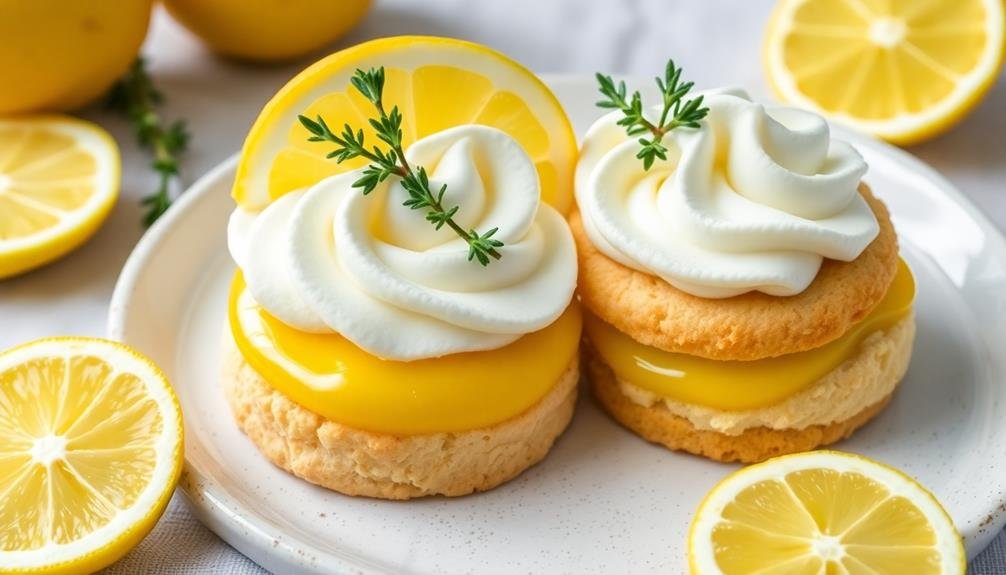
Assembling the shortcake layers is where your dessert truly comes to life. Start by slicing your cooled lemon-thyme shortcake horizontally into three even layers. Place the bottom layer on your serving plate and generously brush it with the lemon-thyme syrup you've prepared earlier. This will guarantee each bite is bursting with flavor.
Next, spread a thick layer of whipped cream over the first cake layer, making sure to cover it completely. Carefully place the second cake layer on top and repeat the process with syrup and cream. Finally, add the top layer and give it a light brush of syrup.
For the finishing touches:
- Dollop a generous amount of whipped cream on top
- Garnish with fresh lemon zest
- Sprinkle some finely chopped fresh thyme leaves
- Add a few edible flowers for a pop of color
- Place a small sprig of thyme on top as a final accent
Your Tangy Thyme-Lemon Shortcake is now ready to serve. The layers of moist cake, infused with herbal notes and zesty lemon, combined with pillowy whipped cream, create a harmonious blend of flavors and textures that'll impress your guests and satisfy your taste buds.
Garnishing With Fresh Herbs
A handful of fresh herbs can elevate your dessert from delightful to extraordinary. For this thyme-lemon shortcake, you'll want to focus on complementary herbs that enhance the existing flavors. Start by selecting fresh thyme sprigs, as they're the star of this dessert. Gently rinse and pat them dry before use.
Place a few small thyme sprigs on top of each shortcake layer, pressing them lightly into the whipped cream. For a pop of color and added freshness, consider adding a few small mint leaves. If you're feeling adventurous, try incorporating a sprinkling of lemon balm or lemon verbena leaves for an extra citrusy kick.
Don't overdo it with the herbs – less is often more. You're aiming for a subtle, aromatic garnish that doesn't overpower the dessert's flavors.
For a final touch, zest a lemon over the top of each shortcake. This will add a burst of citrus aroma and tie the whole dessert together visually.
Pairing With Complementary Teas
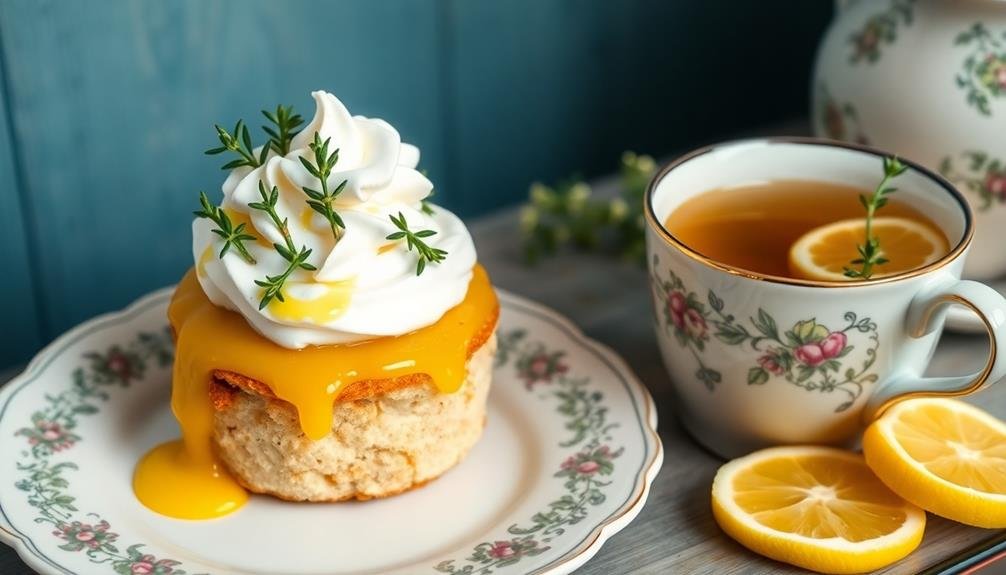
To complete your herbal tea-inspired dessert experience, selecting the right tea pairing is essential. Consider complementary flavors that'll enhance your Tangy Thyme-Lemon Shortcake without overpowering it. A light, citrusy tea can accentuate the lemon notes, while a robust herbal blend might echo the thyme's earthiness.
When choosing your tea pairing, keep these factors in mind:
- Flavor intensity: Match the tea's strength to your dessert's boldness
- Temperature: Serve hot tea with warm shortcake, or iced tea with chilled portions
- Aroma: Select teas with scents that harmonize with your dessert's fragrance
- Tannin content: Opt for low-tannin teas to avoid overwhelming your palate
- Caffeine level: Consider the time of day and your guests' preferences
For this specific dessert, you might try a chamomile-lemon blend, which complements the citrus notes while adding a soothing element. Alternatively, a light green tea infused with mint can provide a revitalizing contrast to the rich shortcake.
Don't be afraid to experiment with different combinations to find your perfect pairing. Remember, the goal is to create a harmonious balance between your dessert and the chosen tea.
Seasonal Variations and Adaptations
Seasons bring a bounty of fresh flavors to inspire variations on your Tangy Thyme-Lemon Shortcake. In spring, try infusing the cream with delicate lavender or replacing thyme with fresh mint.
Summer calls for ripe berries; fold mashed strawberries into the cream or top with fresh blueberries. You can also experiment with lemon balm instead of thyme for a more pronounced citrus note.
As autumn approaches, incorporate warming spices like cinnamon or nutmeg into the shortcake batter. Swap lemon for orange zest and juice for a cozy twist.
Consider adding finely chopped rosemary to complement the thyme. Winter adaptations might include using preserved lemons for intensity or garnishing with candied citrus peel.
You can adjust the sweetness level to match seasonal fruits. For tarter berries, increase the sugar slightly. When using sweeter fruits like peaches or figs, reduce the sugar accordingly.
Don't forget to adapt your tea pairings to match these seasonal variations. A light green tea works well with spring and summer versions, while a robust black tea complements fall and winter adaptations.
Health Benefits of Thyme
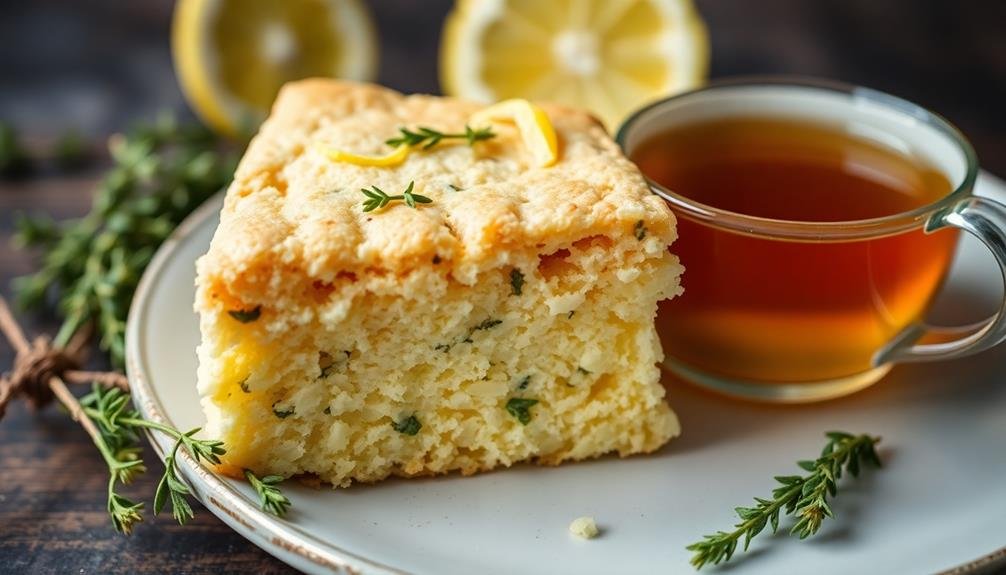
While seasonal adaptations offer variety, incorporating thyme in your dessert brings more than just flavor. This aromatic herb packs a powerful punch of health benefits that you'll enjoy with every bite.
Thyme's rich antioxidant content helps combat free radicals, potentially reducing the risk of chronic diseases. It's also known for its antimicrobial properties, which can support your immune system.
You'll find thyme to be a versatile addition to your diet, offering:
- Respiratory support, helping to soothe coughs and bronchitis
- Digestive aid, potentially easing stomach discomfort
- Blood pressure regulation, thanks to its potassium content
- Mood enhancement, with its uplifting aroma
- Skin health improvement, due to its antibacterial properties
Storing and Serving Tips
Your herbal tea-inspired dessert's longevity and presentation are essential for maximum enjoyment. Store your Tangy Thyme-Lemon Shortcake in an airtight container in the refrigerator for up to three days. Before serving, let it sit at room temperature for 15-20 minutes to enhance its flavors and texture.
When it's time to serve, consider these presentation ideas to impress your guests:
| Plating Style | Garnish | Accompaniment |
|---|---|---|
| Stacked | Fresh thyme sprig | Lemon zest |
| Deconstructed | Candied lemon peel | Whipped cream |
| Layered | Edible flowers | Thyme-infused syrup |
| Mini portions | Powdered sugar | Lemon sorbet |
To maintain the shortcake's integrity, use a serrated knife for clean cuts. If you're serving it as a dinner party dessert, pre-slice individual portions and arrange them on a decorative platter. Don't forget to pair your dessert with a complementary beverage, such as iced thyme tea or a citrusy cocktail, to enhance the overall dining experience. By following these storing and serving tips, you'll guarantee your Tangy Thyme-Lemon Shortcake is always at its best.
Herbal Tea Dessert Pairings
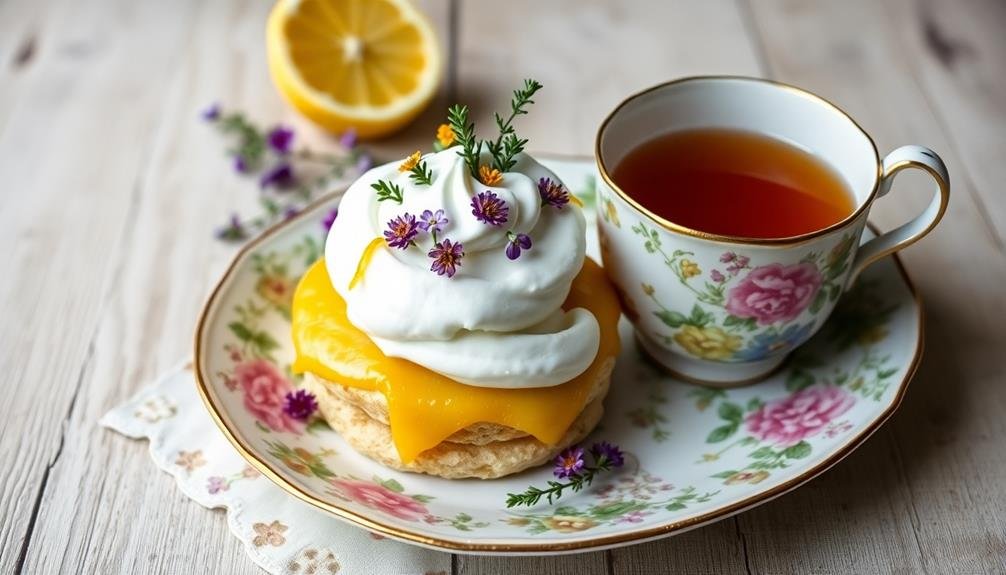
Pairing the right herbal tea with your Tangy Thyme-Lemon Shortcake can elevate your dessert experience to new heights. Consider complementing the tangy and herbaceous flavors of your shortcake with a harmonious tea selection. A light, citrusy tea like lemongrass or lemon verbena will enhance the lemon notes, while chamomile can provide a soothing contrast to the thyme's earthiness.
For a more adventurous pairing, try a mint tea to add a revitalizing twist or a ginger tea for a spicy kick. Remember, the goal is to create a balanced flavor profile that doesn't overpower the dessert.
Here are some herbal tea pairings to experiment with:
- Lemon balm tea
- Lavender tea
- Rooibos tea
- Hibiscus tea
- Rosehip tea
When serving, brew your chosen tea slightly stronger than usual to stand up to the dessert's flavors. You can also consider icing the tea for an invigorating summer treat.
Don't be afraid to mix and match different teas to create your own unique blend that perfectly complements your Tangy Thyme-Lemon Shortcake. With these pairings, you'll transform a simple dessert into a memorable culinary experience.
Frequently Asked Questions
Can I Use Dried Thyme Instead of Fresh in This Recipe?
You can use dried thyme instead of fresh in this recipe. However, you'll need to adjust the amount. Generally, use one-third the amount of dried herbs compared to fresh. Remember, dried thyme has a more concentrated flavor.
Is It Possible to Make This Dessert Gluten-Free?
Yes, you can make this dessert gluten-free. You'll need to substitute the regular flour with a gluten-free alternative like almond flour, coconut flour, or a gluten-free all-purpose blend. Be sure to adjust the liquid content accordingly.
How Long in Advance Can I Prepare the Components?
You can prepare most components up to 2 days in advance. Make the shortcake dough and store it chilled. Whip the cream and create the lemon-thyme syrup ahead of time. Assemble just before serving for the best results.
What's the Best Way to Infuse Thyme Flavor Into the Cream?
You can infuse thyme flavor into cream by steeping fresh thyme sprigs in warm cream for 30 minutes. Strain out the herbs, then chill the cream before whipping. You'll get a subtle, aromatic thyme essence throughout.
Can I Substitute the Lemon With Another Citrus Fruit?
You can definitely substitute lemon with other citrus fruits. Try orange for a sweeter taste, lime for extra tanginess, or grapefruit for a more complex flavor. Each will bring its unique character to the dessert while maintaining the citrusy essence.
In Summary
You've now mastered the art of tangy thyme-lemon shortcake. This herbal tea-inspired dessert is sure to impress your guests with its unique flavor profile. Don't be afraid to experiment with seasonal variations or pair it with your favorite herbal teas. Remember, you're not just baking; you're creating an experience that combines the best of desserts and herbal infusions. So go ahead, indulge in your creation, and savor every bite of this aromatic delight.

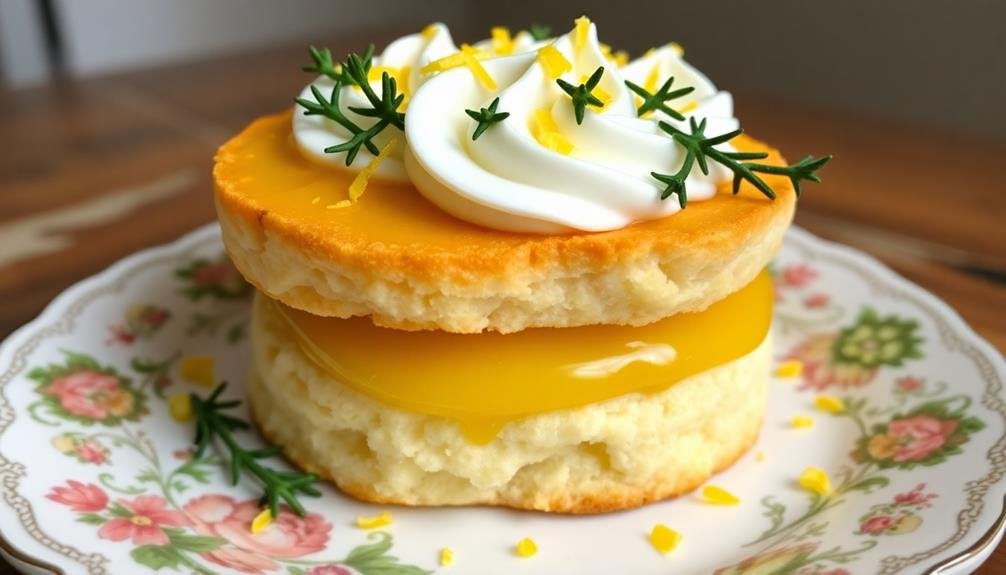
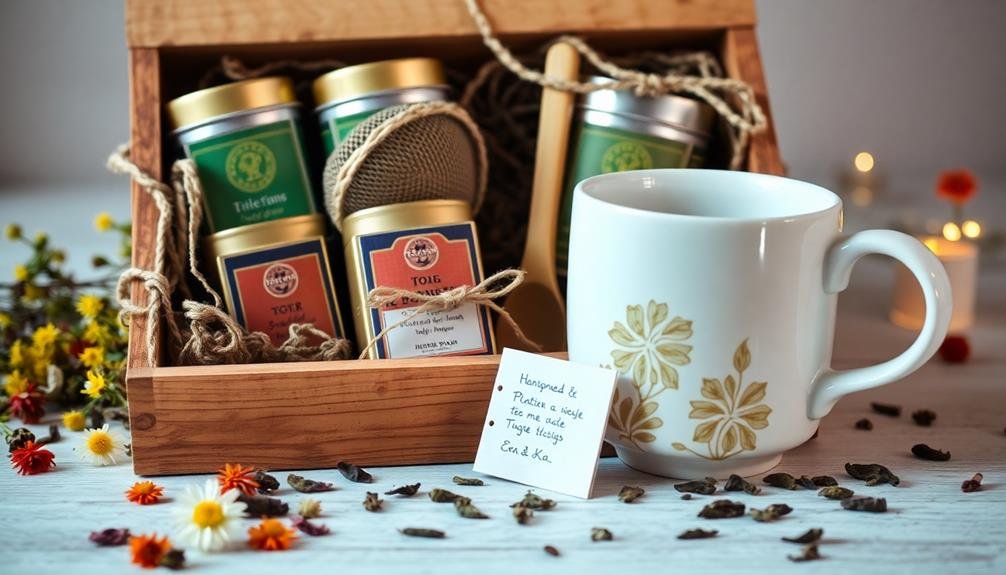
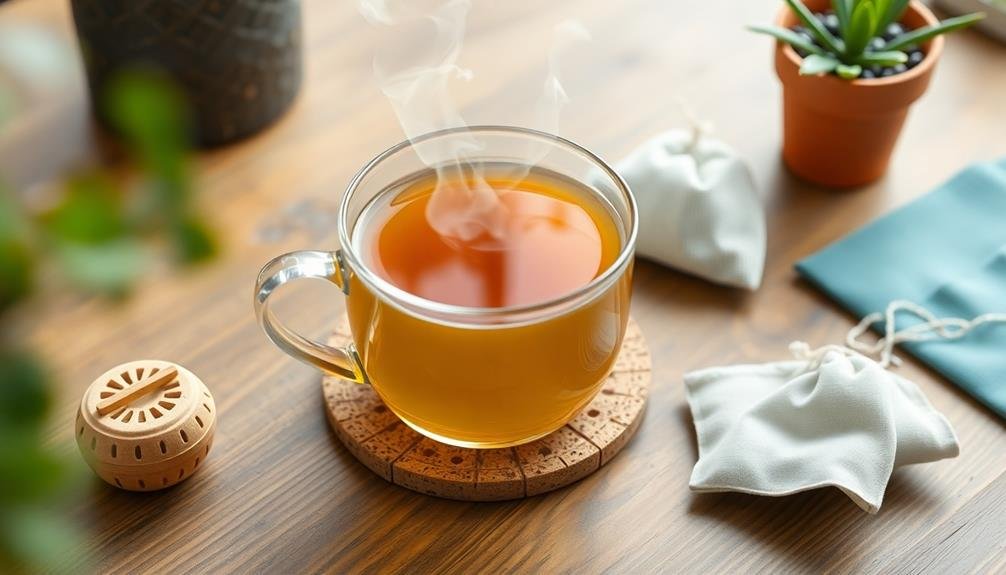

Leave a Reply